For those of us who grew up around Schenectady in the 1950s or 1960s, the northeast corner of State and Broadway seemed long settled as the home of the Woolworth’s — indeed, the F.W. Woolworth store, which opened on that site in 1939, was there until 1994, and the rehabbed building remains. But for an even longer time, that corner housed a series of hotels that were among Schenectady’s best-known.
According to Larry Hart, that corner (then Center Street, not Broadway) had housed a tavern or inn going back at least to the late 1700s. In the late 1850s a new hotel called the Farmers’ House was built. It could also have been known as Montgomery House. Somewhere in there Nicholas Barhydt ran it as a temperance hotel known as the Eagle. (The Barhydt family also owned the property that became the Wallace’s Department Store buildings, so they may have owned much of that block.) It was reported that the building was built (or perhaps rehabbed when it became Carley House) by Adolph Richard Van Dermoor, a contractor who built several other landmarks from the latter half of the 19th century that may all be gone by now.
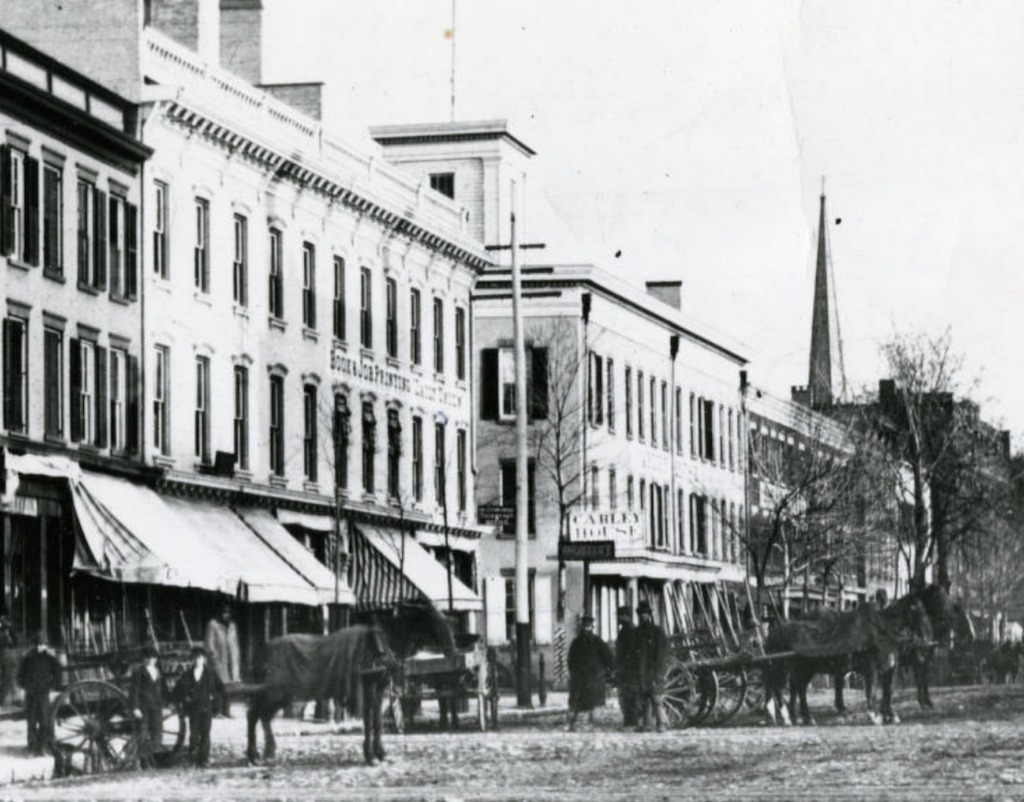
Joseph G. Carley began running it as the Carley House on May 1, 1865, and may have had substantial renovations done by a contractor named Adolph Richard Van Dermoor, who built several other Schenectady landmarks in the latter half of the 19th century that may all be gone by now. (An article says that he “built” the Carley.) Carley quickly won wide acclaim for the quality of hotel he was running. The Saratoga Sentinel wrote in July 1866:
“Some days since, we called upon our old friend Carley, (everybody at Saratoga, and ‘the rest of mankind,’ know ‘Joe,’) at the Hotel (formerly known as the Eagle Hotel, corner of State and Centre streets, Schenectady,) which he opened on the 1st of May last. This Hotel has been thoroughly overhauled and modernized, and is now one of the most elegant north of New York.
We accidentally, of course, struck the hotel at dinner time, and we have never set down to a better table. This we can most consciously assert. The bar is supplied with the choicest of liquors, &c., the attendants are gentlemanly, and ‘Joe’ ‘knows how to keep a hotel.’ We are certain he will secure, as he deserves to, a large amount of public patronage.
We don’t know anything about the bar; but as to the other matters we endorse our friend’s opinion with white chalk ‘all down the back.’”
We have no idea what “white chalk ‘all down the back’” means, but see the comments for some reasonable speculation.
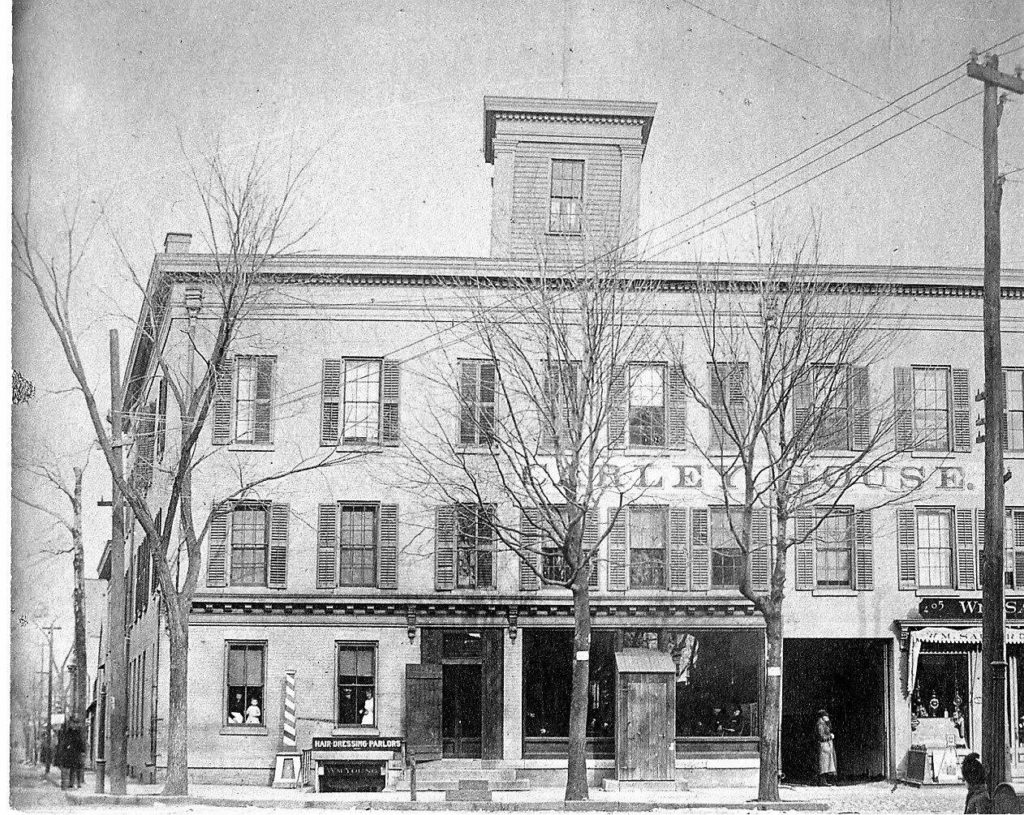
There were lots of ads for activity at Carley House in the years following the Civil War. In 1867, the Evening Star reprinted an article from the Ballston Register which said
“We can recommend this house to the traveling public, as one of the best hotels. The accommodations are superior, the fare sumptuous, and the waiters attentive. Last, but not least, Mr. J.G. Carley, the gentlemanly proprietor, is ever present and ready to make everything agreeable to his guests. If in Schenectady, stop at the Carley House, State street, corner of Centre.”
In Dec. 1868 Joseph G. Carley offered the lease of his hotel, “good will & furniture.” “The subscriber intending to change his business, offers for sale the Hotel Lease, good will and furniture of the ‘CARLEY HOUSE,’ formerly Eagle Hotel, in the city of Schenectady. This Hotel is situated about 1000 yards from the Depot, is an old stand. Has been repaired and newly furnished within 2-1/2 years, and has plenty of shed and yard room.”
That was certainly true. Just looking at the frontage and the relatively few stories of the hotel (especially given that the street level had storefronts), one might wonder just where guests were supposed to stay.
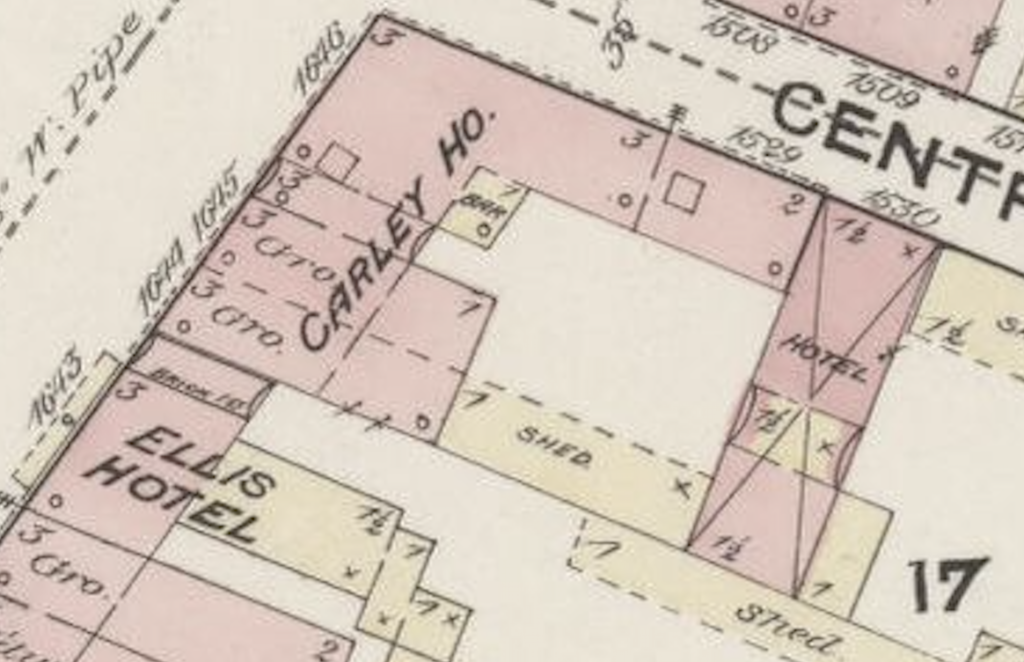
Andrew Diefendorf (sometimes given as Devendorf) of Little Falls leased the Carley House in 1876. Following him, Lewis Sickler, who had run the Nellis House in Canajoharie, took it over in 1882. The Carley House was noted for hosting many public auctions, organization meetings, political conventions, even a court martial. Charles Barhydt took it over in 1891 and ran it as Barhydt House.
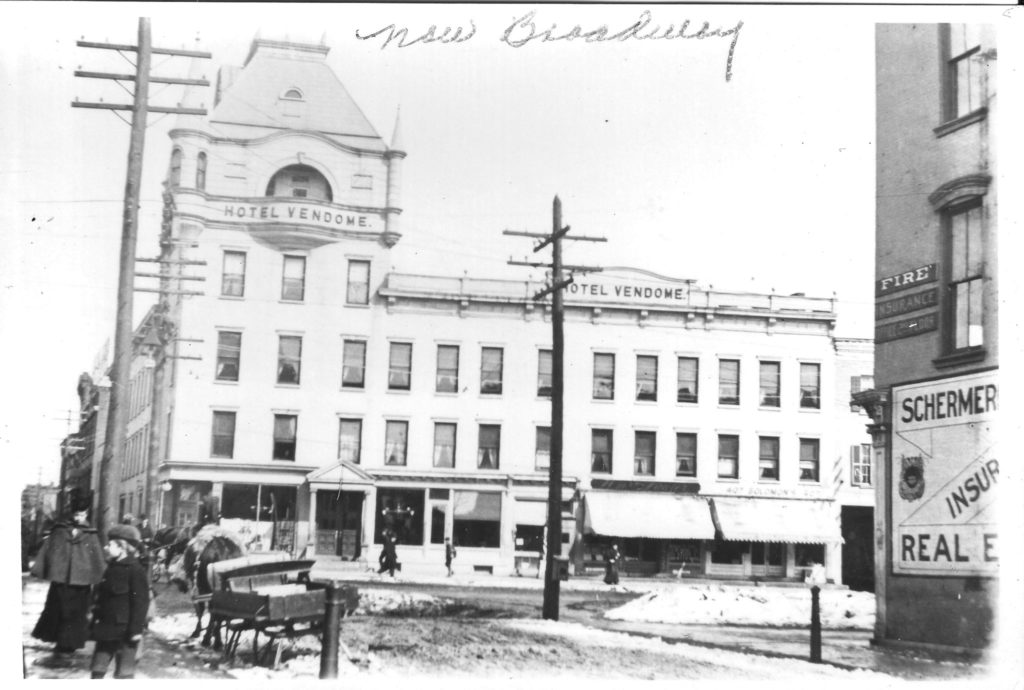
In 1895, according to Larry Hart, H.A. Peck came in and named it The Vendome, a stylish reference to France shared by a number of other hotels of the day. Edwin Clute took it over in 1903 (again according to Hart; some sources have him there in 1895). Around 1909, management changed to William Gleason, who chose to call it the New Vendome, and it “was he who hired a string trio, directed by Stephen St. John, to play soft dinner music to the delight of the patrons.”
Hart reported, “It was an impressive looking structure, its brick exterior painted white until sandblasted to a natural finish shortly before its demise in 1938. Basically, the old inn was three floors in both directions as it straddled the corner with a six-story clock tower at the apex. It was this ornamental cupola which made the Vendome a landmark for Schenectadians from the time it was remodeled from the Barhydt House in 1895.”
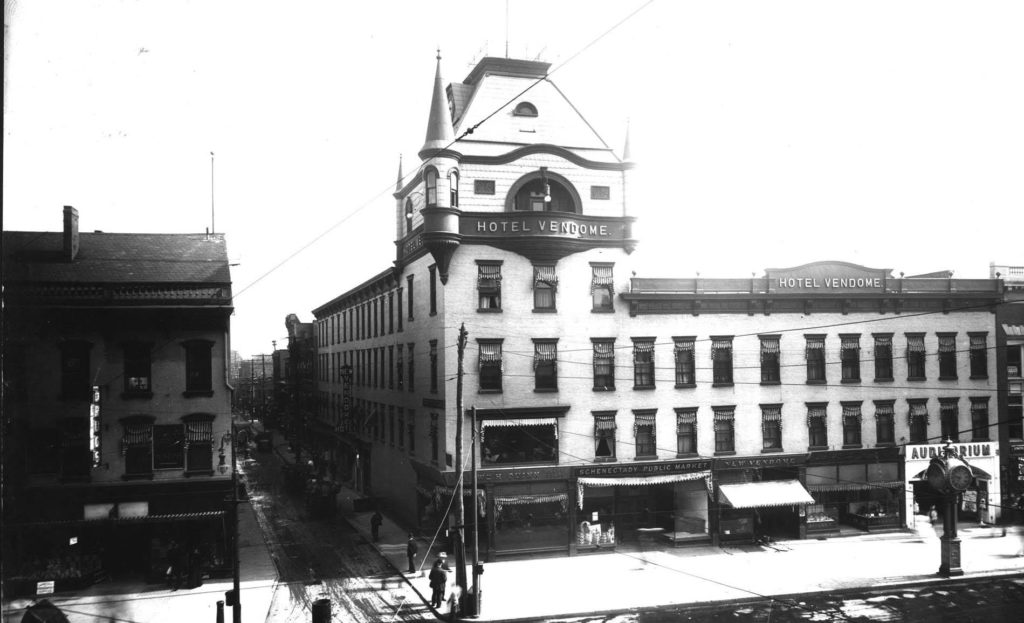
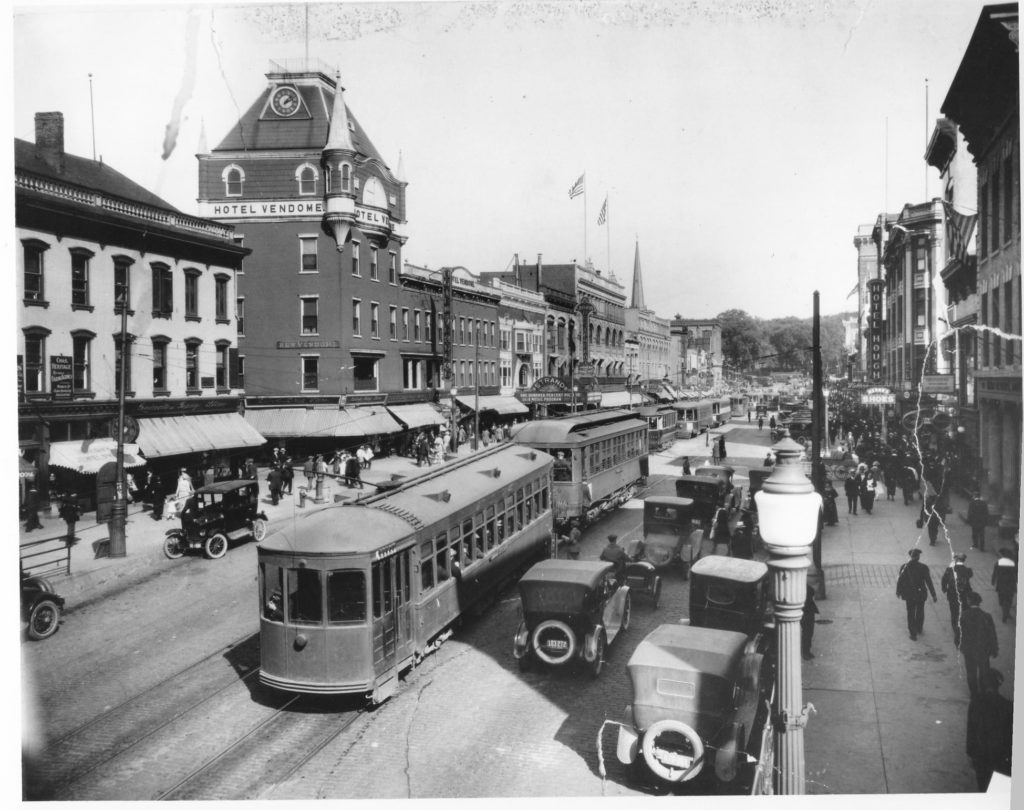
In December 1922, the Vendome Hotel burned . . . and burned . . . and burned. A fire that began in its cellar on a Saturday afternoon was fought for 22 hours. Though there were no injuries, it did an estimated $250,000 in damage. and was considered the worst fire since a three-day Arcade fire in 1909. Quinn’s drug store, and the Public Market in the building were destroyed, and much of the Vendome was damaged by both fire and water, and the blaze burned through a large portion of the roof. There was also damage to the Paris Cloak and Suit Company and the Walk-Over Boot Shop, located on the first floor, and the Strand Theater, located just east. Because the fire burned on a Saturday afternoon, traditionally a heavy shopping hour, it was lamented that much business was lost by surrounding merchants, but there were no injuries.
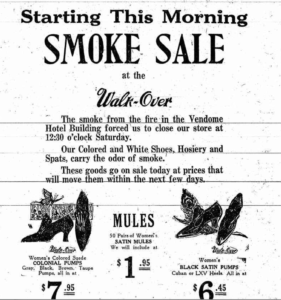
Just a bit more than three months later, in March 1923, the Vendome burned again, this time for more like $50,000 in damages, but all the same businesses were affected. The poor Paris Cloak and Suit Company had gotten all its stock in place and was ready for a re-opening sale, only to have everything ruined by smoke.
“Although the fire temporarily put the Strand theater out of commission . . . the fire did no damage to the interior, although during the blaze in the shoe store the theater cellar was thick with smoke. It was this eventually seeping through to the main auditorium which made it impossible to run the show longer.”
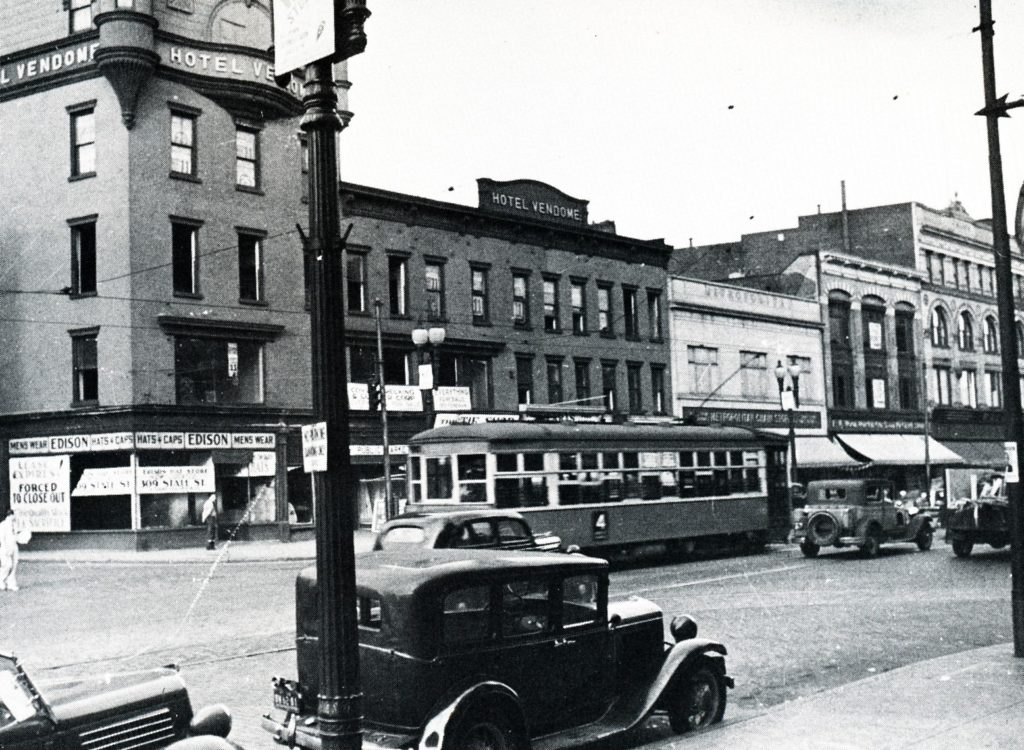
Even that second fire doesn’t seem to have put it out of business, but the pre-eminence of the Hotel Van Curler, which opened in 1925, meant there was less and less mention of The Vendome, and it was no longer so prominent. The Vendome continued until 1938, when it was torn down to make room for a new Woolworth’s Department Store, which had previously been just east, where the Ellis Hotel had once been.
Once it was gone, a restaurant called The Vendome continued across State Street into the 1970s.
We are indebted to Paul Garrow for digging up so many old Vendome photographs.

Leave a Reply